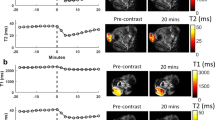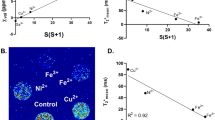Abstract
Recent developments in magnetic resonance imaging and spectroscopy afford the possibility of detecting and assessing transfer, expression and subsequent therapeutic changes of effector or marker transgenes noninvasively. In the field of MR imaging, ‘smart’ MR contrast agents are being developed, so called because they change their conformational structure and in so doing induce MR detectable changes in a given tissue. These agents become ‘switched on’ in response to physiological changes brought about by the enzymatic action of a given gene product (enzymes), and are being developed for use in intact cells, isolated organs and animal models. Ultimately, these agents hold the promise of bridging the gap between the laboratory and the patient with noninvasive detection of transgene expression in vivo in man. Similarly, magnetic resonance spectroscopy is being developed as a noninvasive method to assess transgene expression indirectly by means of MR visible intracellular markers. These markers take the form of intracellular endo/exogenous metabolites associated with exogenous enzyme expression and function. Again, this technique will be applicable to a variety of different situations, from cell suspensions through to clinical imaging of the whole body. In this article the unique opportunities for laboratory-based and clinical studies afforded by MR techniques are discussed.
This is a preview of subscription content, access via your institution
Access options
Subscribe to this journal
Receive 12 print issues and online access
$259.00 per year
only $21.58 per issue
Buy this article
- Purchase on Springer Link
- Instant access to full article PDF
Prices may be subject to local taxes which are calculated during checkout




Similar content being viewed by others
References
Theodore WH, Delgado-Escueta AV, Porter RJ . Frontiers in brain imaging and therapeutics. Introduction Adv Neurol 1999 79: 865–871
Grimm C et al. A comparison between electric source localisation and fMRI during somatosensory stimulation Electroencephalogr Clin Neurophysiol 1998 106: 22–29
Huppertz HJ et al. Estimation of the accuracy of a surface matching technique for registration of EEG and MRI data Electroencephalogr Clin Neurophysiol 1998 106: 409–415
Morucci JP, Rigaud B . Bioelectrical impedance techniques in medicine. Part III: Impedance imaging. Third section: medical applications Crit Rev Biomed Eng 1996 24: 655–677
Roberts TP, Poeppel D, Rowley HA . Magnetoencephalography and magnetic source imaging Neuropsychiatry Neuropsychol Behav Neurol 1998 11: 49–64
Nakaya Y, Mori H . Magnetocardiography Clin Phys Physiol Meas 1992 13: 191–229
Caorsi S, Gragnani GL, Pastorino M . An electromagnetic imaging approach using a multi-illumination technique IEEE Trans Biomed Eng 1994 41: 406–409
Pasini P et al. Chemiluminescence imaging in bioanalysis J Pharm Biomed Anal 1998 18: 555–564
Bloch F, Hansen WW, Packard ME . Nuclear Induction Physics Rev 1946 69: 127
Purcell EM, Torrey HC, Pound RV . Resonance absorption by nuclear magnetic movements in a solid Physics Rev 1946 69: 37–38
Gadian DG . Nuclear Magnetic Resonance and its Application to Living Systems Oxford University Press: London 1982
Bowtell RW et al. NMR microscopy of single neurons using spin echo and line narrowed 2DFT imaging Magn Reson Med 1995 33: 790–794
Mathur de Vre R, Lemort M . Biophysical properties and clinical applications of magnetic resonance imaging contrast agents Br J Radiol 1995 68: 225–247
Kirsch JE . Basic principles of magnetic resonance contrast agents Top Magn Reson Imaging 1991 2: 1–18
Tweedle MF et al. Reaction of gadolinium chelates with endogenously available ions Magn Reson Imaging 1991 9: 409–415
Watson AD, Rocklage SM, Carvlin MJ . Contrast agents. In: Stark D, Bradley WG (eds) Magnetic Resonance Imaging Mosby-Year Book: Missouri 1992 372–437
Desser TS et al. Dynamics of tumour imaging with Gd-DTPA-polyethylene glycol: dependence on molecular weight J Magn Reson Imaging 1994 4: 467–472
Earls JP, Bluemke DA . New MR imaging contrast agents Magn Reson Imaging Clin N Am 1999 7: 255–273
Clement O et al. Contrast agents in magnetic resonance imaging of the liver: present and future Biomed Pharmacother 1998 52: 51–58
Low RN . Contrast agents for MR imaging of the liver J Magn Reson Imaging 1997 7: 56–67
Cady EB . Clinical Magnetic Resonance Spectroscopy Plenum Press: New York 1990
Rothman DL et al. 1H-[13C] NMR measurements of [4-13C] glutamate turnover in human brain Proc Natl Acad Sci USA 1992 89: 9603–9606
Roden M, Shulman GI . Applications of NMR spectroscopy to study muscle glycogen metabolism in man Annu Rev Med 1999 50: 277–290
Thomas EL et al. An in vivo13C magnetic resonance spectroscopic study of the relationship between diet and adipose tissue composition Lipids 1996 31: 145–151
Cheng LL, Chang IW, Louis DN, Gonzalez RG . Correlation of high-resolution magic angle spinning proton magnetic resonance spectroscopy of histopathology of intact human brain tumor specimens Cancer Res 1998 58: 1825–1832
Barton SJ et al. Comparison of in vivo1H MRS of human brain tumours with 1H HR-MAS spectroscopy of intact biopsy samples in vitro MAGMA 1999 8: 121–128
Tsien RY . Rosy dawn for fluorescent proteins Nat Biotechnol 1999 17: 956–957
Szczepaniak LS et al. Nuclear magnetic spin-lattice relaxation of water protons caused by metal cage compounds Bioconjug Chem 1992 3: 27–31
Moats RA, Fraser SE, Meade TJ . A ‘smart’ magnetic resonance imaging agent that reports on specific enzymatic activity Angew Chem Int Ed Engl 1997 36: 726–728
Jacobs RE, Ahrens ET, Meade TJ, Fraser SE . Looking deeper into vertebrate development Cell Biology 1999 9: 73–76
Hüber MM et al. Fluorescently detectable magnetic resonance imaging agents Bioconjug Chem 1998 9: 242–249
Li W-H, Fraser SE, Meade TJ . A calcium sensitive magnetic resonance contrast agent Proc 7th Ann Mtg Internat Soc Magn Reson Med 1999 1: 343
Li W-H, Fraser SE, Meade TJ . A calcium-sensitive magnetic resonance imaging contrast agent J Am Chem Soc 1999 121: 1413–1414
Kayyem JF, Kumar RM, Fraser SE, Meade TJ . Receptor-targeted co-transport of DNA and magnetic resonance contrast agents Chem Biol 1995 2: 615–620
Jalan R, Taylor-Robinson SD, Hodgson HJF . In vivo hepatic magnetic resonance spectroscopy: clinical or research tool? J Hepatol 1996 25: 414–424
Menon DK et al. Effect of functional grade and aetiology on in vivo hepatic phosphorus-31 magnetic resonance spectroscopy in cirrhosis: biochemical basis of spectral appearances Hepatology 1995 21: 417–427
Taylor-Robinson SD et al. In vivo and in vitro hepatic 31P magnetic resonance spectroscopy and electron microscopy of the cirrhotic liver Liver 1997 17: 198–209
Stegman LD et al. Noninvasive quantitation of cytosine deaminase transgene expression in human tumour xenografts with in vivo magnetic resonance spectroscopy Proc Natl Acad Sci USA 1999 96: 9821–9826
Ikehira H et al. A preliminary study for clinical pharmacokinetics of oral fluorine anticancer medicines using the commercial MRI system 19F-MRS Br J Radiol 1999 72: 584–589
Kievit E et al. Superiority of yeast over bacterial cytosine deaminase for enzyme/prodrug gene therapy in colon cancer xenografts Cancer Res 1999 59: 1417–1421
Walter G, Barton-Davis E, Shoturma DI, Sweeney HL . Noninvasive measurement of gene expression in skeletal muscle Proc 7th Ann Mtg Internat Soc Magn Reson Med 1999 1: 343
Bell JD et al. A 31P and 1H-NMR investigation in vitro of normal and abnormal human liver Biochem Biophys Acta 1993 1225: 71–77
Hofmann C, Strauss M . Baculovirus-mediated gene transfer in the presence of human serum or blood facilitated by inhibition of the complement system Gene Therapy 1998 5: 531–536
Bell JD, Preece NE, Parkes HG . NMR of body fluids and tissue extracts. In: Gillies RJ (ed) NMR in Physiology and Biomedicine Academic Press: London 1994 221–236
Nicholson JK, Lindon JC, Holmes E . ‘Metabonomics’: understanding the metabolic responses of living systems to pathophysiological stimuli via multivariate statistical analysis of biological NMR spectroscopic data Xenobiotica 1999 29: 1181–1189
Acknowledgements
We would like to thank Dr Michael J McGarvey, Department of Medicine, Imperial College School of Medicine, London, UK for his advice and Dr Tom Meade and Angelique Louie, Beckman Institute, California Institute of Technology, Pasadena, CA, USA for useful discussions and the reproduction of their diagrams in this review.
Author information
Authors and Affiliations
Rights and permissions
About this article
Cite this article
Bell, J., Taylor-Robinson, S. Assessing gene expression in vivo: magnetic resonance imaging and spectroscopy. Gene Ther 7, 1259–1264 (2000). https://doi.org/10.1038/sj.gt.3301218
Published:
Issue Date:
DOI: https://doi.org/10.1038/sj.gt.3301218
Keywords
This article is cited by
-
NMR spectroscopy for metabolomics in the living system: recent progress and future challenges
Analytical and Bioanalytical Chemistry (2024)
-
Hapten-derivatized nanoparticle targeting and imaging of gene expression by multimodality imaging systems
Cancer Gene Therapy (2009)
-
The challenges for molecular nutrition research 2: quantification of the nutritional phenotype
Genes & Nutrition (2008)
-
Non-invasive Imaging in Gene Therapy
Molecular Therapy (2007)
-
In vivo NMR imaging evaluation of efficiency and toxicity of gene electrotransfer in rat muscle
Gene Therapy (2005)



